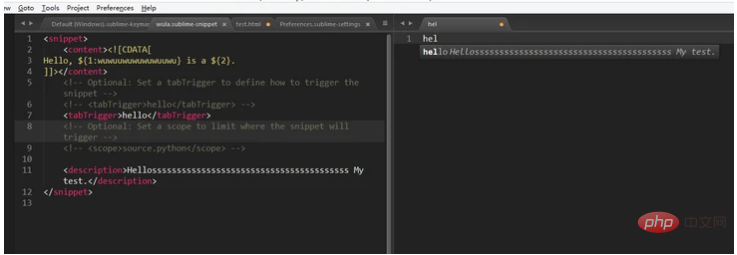下面由 sublime 教程栏目给大家介绍sublime Snippet如何编写! sublime Snippet编写 snippet content![CDATA[ Hello, ${1:wuwuuwuwuwuwuuwu} is a ${2}. ]]/content !-- Optional: Set a tabTrigger to define how to trigger the snippet

sublime Snippet编写
<snippet>
<content><![CDATA[
Hello, ${1:wuwuuwuwuwuwuuwu} is a ${2}.
]]></content>
<!-- Optional: Set a tabTrigger to define how to trigger the snippet -->
<!-- <tabTrigger>hello</tabTrigger> -->
<tabTrigger>hello</tabTrigger>
<!-- Optional: Set a scope to limit where the snippet will trigger -->
<!-- <scope>source.python</scope> -->
<scope>text.html</scope>
<description>Hellossssssssssssssssssssssssssssssssssssssss My test.</description>
</snippet>snippet是片段的意思,就是说智能提示的概念。
content是片段内容,scope标签是触发的文件类型,tagTrigger是触发的关键字,description是注释说明
他和macro的区别是:
宏的操作都是需要用快捷键的,而且保存的宏必须加载在系统keymap文件user自定义部分当中。
eg:
对已经保存的宏的操作:
[ { "keys": ["ctrl+shift+;"], "command": "run_macro_file", "args": {"file": "res://Packages/User/test.sublime-macro"} } ]
而snippet操作是用于只能提示,只要文件保存了系统就会自动加载,不需要keymap。
但是,marco是对多个操作的统一规划,而snippet只是只能提示罢了。
也就是说当你需要一堆有顺序的按键操作的时候,使用marco,记录宏实际上就是记录你的按键顺序。
而当你想加载一个模板或者智能提示时,用snippet
效果如图所示

以上就是sublime Snippet如何编写的详细内容,更多请关注自由互联其它相关文章!
